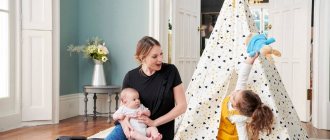When the child begins to coo, the young mother becomes indescribably delighted. Many new parents are really looking forward to this moment; they ask pediatricians and more experienced mothers and fathers about how many months does the child begin to speak his own language, draw out vowels, coo, and coo.
Below we will tell you at what months a child begins to pronounce the first vowels and consonants, and what this event depends on. You will also learn how you can encourage your baby to make feather sounds and what to do if time passes and he is still silent.
It is worth remembering that cooing and humming are different concepts that differ in the set of sounds. When cooing, vowel sounds predominate in speech, and when humming, which appears after 1.5 months, consonant sounds appear in combination with vowels.
Baby's first sounds
The first sounds or when the baby starts to coo? Note that for about the first five weeks you can only hear crying or grunting from the baby. And only by the second month of their life can babies begin to make their very first sounds. Usually the first sounds emitted are vowels that are not difficult to pronounce: a, u, o, e. At the moment of pronouncing these vowels, parents hear the long-awaited “aha”.
The baby begins to coo at 1-2 months, during this period they communicate with themselves, that is, they become familiar with new skills. Children watch the sound source for a very long time, and also try to reproduce it more and more often. Next, they try to apply their skills in communicating with family or toys. Quite often they begin to hum to a melody, which they really like. From the outside it seems that the baby is singing along.
Around the fourth month, babies begin to try to pronounce the first consonants. At first you can hear from them: m, p, b. And then, more and more often, you will hear individual syllables, from which the baby’s babbling gradually begins to form. By the end of the first year, children are already beginning to pronounce their first words, which consist of the same syllables.
First vowels
A newborn does not yet know how to do anything except grunt and cry to declare his inconvenience and discomfort. Crying is the beginning, that is, the very first way a little person communicates. In the first 4-5 weeks after birth, some babies squeak funny, but you won't hear much more from them.
There is a chance to catch the first vowels by the second month of life: he begins to draw sounds [a], [o], [e], [u] and combinations of sounds [a-a-a-a, ua-ua-ua-ua, ue -ue-ue-ue, wow-wow-wow-wow]. Because of the guttural pronunciation, it seems to us that the baby has learned to say agu or agi.
First, the child begins to hum for himself, he “tastes” his new skill, draws vowels this way and that, and it seems to the mother that the baby is singing. Once the baby has become comfortable with the novelty, he will begin to use humming to communicate with mom, dad, or toys. Some children “talk” for a long time with the pictures on the sides of the crib and with the hanging mobile, and when they see their own face they become even more active in the conversation. The baby, who has begun to gurgle, is delighted with his new ability.
Learning to coo
Gurgling is a fairly significant process in the further formation of speech. It is absolutely impossible to specifically teach a baby to walk. But some actions on the part of the parents will definitely help the child quickly begin to communicate with the world that surrounds him.
So, at what months does the baby start to coo, we have almost figured it out. Therefore, now we should highlight certain points that can speed up this process. What parents should do:
- First of all, parents need to communicate with their baby as much as possible. You need to accompany any of your actions with an explanation, that is, tell your baby what you are doing at this very moment. You need to communicate with your baby while changing a diaper, bathing, swaddling, etc. That is, communication should occur while the baby is awake. A conversation between an adult and a child should take place in calm tones, and speech should be affectionate. In no case should you use sharp bursts of hands or a raised tone in a conversation, in this case, you may frighten your child;
- Please note that you need to repeat after the child all his sounds, and also supplement them with new, but simple ones. Children begin to try to repeat what was said. The “ahu” dialogue should take place with the baby and parents, accompanied by a smile, then the baby begins to hum and smile;
- During a conversation, you need to massage the baby's hands with light and gentle movements. It is on the baby’s hands that there are points that are associated with areas of the brain that are responsible for the development of speech. Also, these manipulations can develop fine motor skills in the baby.
When communicating with a newborn, you should not distort words, as they will not hear the correct pronunciation, which in turn can harm the further development of speech. Try to read short poems, folk jokes, etc. to your baby as often as possible. Such actions will contribute to active development.
How to teach a skill?
In order for your baby to start walking, it is important to perform simple exercises with him, thanks to which he will soon begin to make melodious, drawn-out sounds.
- Sing songs. Lullabies and calm children's songs will help the baby consolidate the experience of humming and begin to coo sooner. The combination of drawn-out vowels with admixtures of abrupt consonants is a strong stimulus for the development of the baby’s speech.
Reference! Today there are many drawling songs with the alphabet. Thanks to them, the child will learn to walk and already remember things necessary for a much later age.
- Get massages. Massaging the baby's palms and fingers, as well as the feet, will help him start talking sooner (you will also be interested to know when the baby starts talking). The nerve endings contained in the fingertips are directly related to the development of speech. You can start doing a light massage from the first days of the baby’s life, and at an older age (from 6 months), under the supervision of adults, you can let him play with cereals (beans, peas, millet, etc.), which is the best method for the development of small and gross motor skills.
- Read poems, fairy tales, nursery rhymes and other children's works. This will develop not only the baby’s speech, but also memory.
The baby is a month old and he is still silent
There is no need to worry if a newborn is not cooing by the end of the first month, because they are not mechanical devices in which the pace of development is set. That is, every baby develops as he needs. At how many months does a baby start to coo is a very individual question. One baby begins to try to pronounce “aha” already at three weeks, while the other is still silent, but he will begin to delight others with pleasant sounds a little later. Silence may be due to the fact that the child will be silent by nature.
There are also cases when the baby began to gurgle quite early, but then suddenly fell silent. You shouldn’t stress yourself out and worry, as the baby is simply beginning the period of preparation for the next portion of speech skills. After a certain period of time, the hooting will return, but accompanied by laughter, squeaking and squealing. It also happens that sudden silence can be caused by a number of certain factors, for example, due to stress or poor health.
If your child is silent for a long time, you should seek help from a pediatrician. You should start worrying after eight months. Perhaps the baby has developed some problems with neurology or with the hearing aid. The pediatrician should refer the child to a specialist, for example, a neurologist or otolaryngologist, to determine the causes of delayed speech development and their treatment.
How parents can help with boozing
Humming and babbling can be seen as ways of finding new ways to communicate. Parents should take this into account and support the baby by talking to him. This can be done like this:
- always respond to the sounds that the baby makes, encourage him;
- treat speech kindly - smile, show that the child is doing everything right, that his actions are pleasant to the parents;
- actively articulate when communicating;
- use gestural techniques to make speech more expressive; Sometimes you can also make a face to maintain interest;
- communicate actively and clearly.
It is also necessary to ensure that the process of speech development occurs in a calm environment, when there are no unpleasant or distracting factors.
Usually, a baby does not begin to coo in order to inform the parent about his needs or desires. Walking is perceived as a game, so in order for speech learning to be effective, you need to create favorable conditions for this - the baby must be clean, healthy and well-fed.
How is cooing different from humming?
When babies begin to coo and gurgle, parents experience a lot of joyful sensations. Gurgling is the sound of vowel sounds from a child's mouth, and humming is a speech form that is more complex.
Consonants begin to appear in sounds, for example: g, k, x in combination with vowels. Then you can hear: agu, ky, khy, gu. The walking stage can last up to four or five months. Sometimes these sounds arise spontaneously in a baby, for example, when studying a toy. However, gradually the baby will begin to use humming and cooing in response to communication or a smile from a loved one.
During the period when the baby begins to communicate, parents should understand that this is a rather important stage in the timely and correct development of the child. Three months are considered to be the peak of the boom. This is exactly the age when you should have a camera at hand so that you always have the opportunity to film the baby’s unique songs. Very often, newborns begin to hum along to certain songs, it turns out as if the baby is singing along.
When should a child start talking?
First of all, it is important for parents to understand that the child does not owe anything to anyone. It develops in accordance with its internal rhythm, which can differ greatly from the average statistical norms. It happens that a baby who uttered his first words very early will subsequently have a very slow expansion of his vocabulary. And vice versa, a silent person who looked like a black sheep compared to his peers can suddenly overtake them all.
When assessing your child’s progress, we recommend that you do not take the stories of your friends to heart: many mothers and fathers greatly exaggerate the successes of their child. It’s better to focus on the following key points of speech development (not forgetting that each baby’s schedule is individual).
| 2–4 months | Gurgling At this time, the baby begins to “walk” and “gurg.” He is not yet trying to speak, he is simply aware of the fact that certain movements of the speech apparatus can turn into sounds. That’s why “agu” is completely international—it’s a “word” that comes naturally when you open and close your mouth. |
| 6 months | Gurgling At this time, the baby begins to “walk” and “gurg.” He is not yet trying to speak, he is simply aware of the fact that certain movements of the speech apparatus can turn into sounds. That’s why “agu” is completely international—it’s a “word” that comes naturally when you open and close your mouth. |
| ~ 1 year | First words By his first birthday, the baby learns his first real words. Yes, these are rather primitive “mom”, “dad”, “woman”, but they are no longer just a set of sounds. The child understands the meaning and addresses them to specific adults. Soon the toddler's speech is replenished with other simple words. For example, he more or less clearly screams “oops” when he drops a toy, or “give” when he wants to get something. A baby's primary vocabulary usually consists of 5–10 words. |
| 1-1.5 years | Vocabulary expansion Every week the child pleases his parents with new words, but mom and dad cannot always understand the child’s “dialect.” The fact is that the baby already distinguishes many words in the speech of adults, but he cannot repeat them. So “porridge” turns into “ka”, “fell” into “apa”, “bird” into “tika”. Often, a child comes up with conceptual words that combine several objects at once, for example, he uses one syllable to designate everything soft and warm - from a blanket to a dog. The baby's set of first words is limited to nouns, verbs, and interjections. When assessing a child’s development, it is important for parents to first assess not the number of words he speaks, but the passive vocabulary that he clearly understands in adult speech. |
| 1.5-2 years | First proposals This is the period when children begin to speak more and more actively. The baby learns two very important words for communication - “yes” and “no”. He repeats what he hears, and may even remember entire phrases. The vocabulary expands significantly and reaches 250 or more words. It continues to be dominated by the names of surrounding objects and basic actions, but the first abstract expressions appear, for example, “hello” and “bye.” The baby understands that words work better together and learns to form the first sentences. They are quite short - only 2-4 words, but they allow you to clearly express your desires. |
| 2-3 years | Full speech The baby’s speech becomes almost adult, because after nouns and verbs the first words related to other parts of speech appear in it. The baby begins to use pronouns, and at the same time understands that objects have gender and number. He discovers adjectives and now not only names objects, but gives them characteristics. He masters question words and begins to constantly ask you about one thing or another. He is even able to figure out tenses, declensions and conjugations in his head, even if he doesn’t yet know what they are called. By the age of three years, you can fully communicate with your child, and the scope of conversations is not limited to the topics of “eating, playing, sleeping.” The kid knows 800–1000 words, can tell you what he did while visiting his grandmother, answer your questions and ask you a hundred times more. By and large, the child’s speech skills have developed. All that remains is to polish them by continuing to build your vocabulary and practice your pronunciation. |
Speech development of a baby up to six months
We have already studied at what age the baby begins to gurgle, but now it is worth paying attention to what kind of help should be received from parents:
- Constantly communicate with your child. Try to convey to him everything that you do. Speech should be as calm, gentle and clear as possible. Under no circumstances should you raise your voice at your newborn.
- In your stories you should show your emotions, gestures and facial expressions. But do not make any sudden movements so as not to scare the baby. The child will begin to happily repeat the movements of lips, words and sounds after adults. Remember that kids watch all your movements.
- For educational activities, prepare cards with colorful pictures. Explain to the child what is depicted on them.
- Repeat the sounds your baby uses and add new ones.
- Play music and animal sounds for your child.
By six months, the baby will learn to consciously smile and coo; these skills are developed in the child through activities with parents. Give your baby as much attention as possible.
When children start to roar
Often parents do not notice changes in the baby’s pronunciation, missing the moment when the child develops the ability to pronounce individual vowel sounds. Then their speech may seem bizarre and unusual, since the sounds have an extended structure.
Such changes are noticeable already in the second or third month of life. At this age, the first communication skills are formed, when the child tries to communicate through the pronunciation of syllables, as well as simple sound structures. Pronouncing whole words is not typical.
The period of cooing lasts from 2 to 4 months, after which the baby begins to babble and learn to pronounce individual syllables, even words. By the third or fourth month of life, the baby can walk constantly, even for several hours a day without breaks. You can read more in detail in our article - when a child begins to gurgle and coo.
The structure of the cooing changes over time - at first it can be solo fragmentary sounds, which later become smoother, melodic and continuous.
In addition to vowels, when a child gurgles, he can learn to say long consonants like “m”, “s”, as well as the letters “b”, “p”. This makes speech more varied.
What can you do if there is no partying?
There is no need to worry if the baby has not started to walk by the age of 2 months - with normal development, the process of learning the structure of speech is individual, so for some it can happen very quickly, while for others it happens late. Temperament matters - some children start playing very early, while others remain silent for no apparent reason.
You should consult a specialist if your child cannot walk at all by the age of 4 months. In such a situation, the pronunciation of fragmentary or smooth vowel sounds is completely absent. Then some developmental disorders are likely.
There is an opinion that walking can be taught through simple tasks and exercises, when silence is not caused by failures or deviations in intellectual and physical growth. Lack of cooing may be due to lack of communication. To begin with, the mother should talk to the baby more often, sing him calm children's songs and lullabies. When singing, it is advisable to draw out vowel sounds so that they can be heard and remembered.
It is necessary to create the right environment in the family - to ensure peace and well-being. Under no circumstances should you quarrel near a child, as this can ruin the child’s mood and affect the development of his communication skills. Learning sounds begins during play, and if the surrounding environment is unfavorable, the baby will not be able to do this. If relationships within the family improve, the child will quickly learn to walk.
Some doctors and parents recommend starting to develop fine motor skills as early as two or three months of age. Speech skills may depend on the degree of physical development, so you should pay attention to touching the baby’s hands and feet. You can also give him small objects to hold.
It is important not to yell at a child for misbehavior or force him to talk loudly, as this has the opposite effect - due to fear of parents, speech skills do not develop.
It is necessary to pay attention to the intonation of communication and correct it, since by the third month children are able to distinguish shades of mood and grasp the tone of the conversation. If the baby's babbling has begun, it will smoothly move into the babbling stage, in which syllables and simple words are formed.








